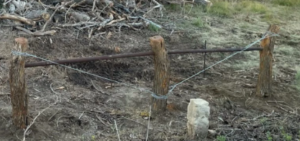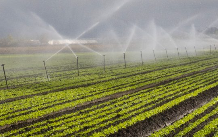For the ranchers who lost so much, the rebuilding process is far from over.
PARADISE, Kansas — These are the survivors.
As rancher Rich Koester walks through his cattle pen, he points them out one by one.
The cow with a plastic ear tag that’s warped from melting in the fire’s heat. Another whose burnt hair never quite grew all the way back. The Black Angus who’s still a little jumpy when Koester tries to separate her from her calf.
It’s been a full year since dry grass and high winds fueled the massive wildfire north of Russell, Kansas, last December that burned across every inch of Koester’s pasture. And some scars still remain.
But signs of hope exist, too.
Koester crouches to feed a handful of hay to a row of calves eagerly peeking their faces through breaks in a gate.
When these baby cattle were born in the weeks after the fire, their mothers’ udders were too badly burned to nurse them. Now one year later, those same mother cows have recovered enough to feed the next generation of calves.
“I always say that when time goes on, time heals,” Koester said. “Time heals up.”
But healing from a disaster this extensive is an uphill climb. Koester and ranchers across the region still face a daunting path forward as they push to rebuild their businesses, their herds and their lives.
On Koester’s property alone, the flames consumed hundreds of acres of grass, destroyed miles of fencing and killed roughly 100 cattle. And because those cattle are his livelihood, he’s had to spend time and money rehabilitating his property and his herd while his business suffers from tremendous financial losses.
“It’s a little bit tighter this year,” Koester said. “We’ll get by … somehow.”
Koester is far from the only rancher facing such challenges. The fire that engulfed his land was the largest of several that day, incinerating more than 190 square miles. That’s an area larger than all of Wyandotte County or the city of Wichita.
His neighbor, Monty Morrill, lost roughly half of his cattle to the same fire. Flames consumed a handful of buildings, some farm implements and an old homestead where his family stayed when they worked in the pasture, too. It melted the plastic trim off of a pickup truck.
Even a year after the fire, he’s still picking up scorched pieces of wood and metal debris scattered across his pastures. 
“It’s starting over from scratch,” Morrill said. “But it’s even worse than starting over from scratch because you’ve got to clean up all the stuff. … It’s going to be a long process.”
As ranchers have picked up the pieces in the fire’s wake, one of their first priorities has been replacing the fences that were destroyed. Without a fence, there’s no way to keep cattle in a pasture.
But with so many people in a rural area needing the same fencing supplies at the same time, it was hard for ranchers to get their hands on the materials they needed to start.
And the amount of supplies they’ve needed has been astronomical.
Monte Nuss, acting director of the Russell County USDA farm services agency, said his office has received relief funding requests for 535 miles of fencing.
If you were to start in Russell and build a 535-mile fence in a straight line heading west, you’d nearly make it to Utah.
“It’s a great undertaking,” Nuss said. “It’s just a slow process.”
Then there’s the price tag. Building a fence can cost around $20,000 per mile, Nuss said.
So the total cost for replacing all of the destroyed fencing in this one county will likely be more than $10 million dollars.
That’s just for one step of the rebuilding effort.
Even a full year after the fire, Nuss said, less than half of the fencing in his county has been replaced.
And for ranchers, that federal relief doesn’t cover the full cost. If a rancher replaces 20 miles of fence at an average cost of $20,000 per mile, the total cost would be $400,000. USDA relief can reimburse for up to 75% of that, which would still leave the rancher with a bill for $100,000.
On top of that, there’s the drought that’s made it tough for pastures to recover after being burnt to a crisp.
In ideal conditions, it still might take a few years for all the grass to grow back. But the historically dry conditions this year haven’t helped. Morrill has been feeding his cattle hay since earlier this fall because there wasn’t much grass left for them to graze.
“Once the rain quit this summer, it was pretty much game over,” Morrill said. “It’s gonna be pretty tough for a few years unless we get some rain in the spring.”
And rebuilding the decimated cattle herds will take even longer than replacing the grass they eat and the fences that corral them.
In Russell County alone, the fire killed 1,711 cattle — 1,359 cows, 36 bulls and 316 calves — according to data from the county’s USDA farm services agency. The USDA office has paid out just north of $1.3 million to Russell County cattle producers to help cover those losses.
Local community donations and other organizations have helped, too. The Kansas Livestock Association, for instance, distributed $2 million in disaster relief funding to 94 farmers statewide, including Morrill.
But Nuss said the losses the ranchers endured stretch beyond what you can write on a check.
Some of the cows that died in the fire were about to give birth, so it’s essentially losing two generations of cattle and a year’s worth of work.
“Where they lost cows … they lose income,” Nuss said. “No cows means no calves.”
That’s what happened to Koester. His income from raising cows and their calves has been way down this year, he said, because he hasn’t had the calves to sell. And it’ll take at least a couple more years for him to get his herd numbers back up to where they were.
Morrill sells bulls from a bloodline that his family has painstakingly bred for generations. So replacing the animals he lost isn’t as simple as just buying some new ones at auction.
“You have to make those cows,” Morrill said. “(The fire) pretty well killed our business.”
He had planned to sell more than two dozen bulls this year. Because of the fire, he only had eight of them.
He estimates it’ll be at least a decade before he can fully restore his cattle herd and business. But that’s exactly what he plans to do.
“You don’t have a choice,” Morrill said. “You’ve got a family to take care of.”
In Koester’s pasture, the land looks vastly different than it did a year ago.
Red swaths of regrown little bluestem grass rise and fall on distant hills. Yucca plants that were reduced to charred stumps are now adorned with crowns of long, green leaves. The layer of tan ash that blanketed just about everything has blown away or blended into the dirt.
Over the past several months, Koester and his family have gradually replaced a couple of miles of his ruined fence, too — one wooden post, steel stake and stretch of barbed wire at a time.
“You just kind of keep going,” Koester said. “Some people ask me, ‘Aren’t you going to retire?’ And I go, ‘No, this is my life.’”
One silver lining of this tragedy, he said, is that having his family work together to rebuild the fence has brought them closer together and given his daughters a better idea of his life’s work.
But the process is far from over. Koester estimates that this fence project is only around halfway done.
“It’s gonna get better again,” Koester said. “That’s the way I always look at it. … We’ve gone through the worst part of it, so it’s gotta look up.”
Resources for Kansans experiencing stress or despair in the wake of wildfires, drought and other disasters:
-Kansas Ag Stress, statewide mental health resources for producers and their families
https://www.kansasagstress.org/
24/7 hotline: 1-800-447-1985




